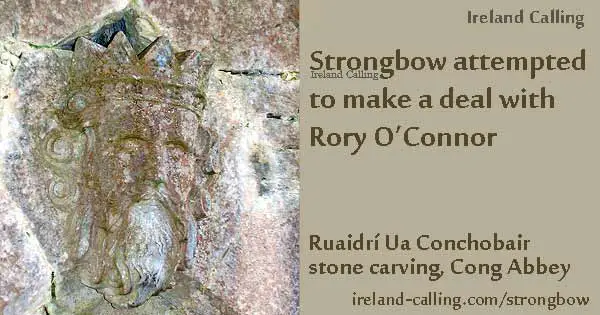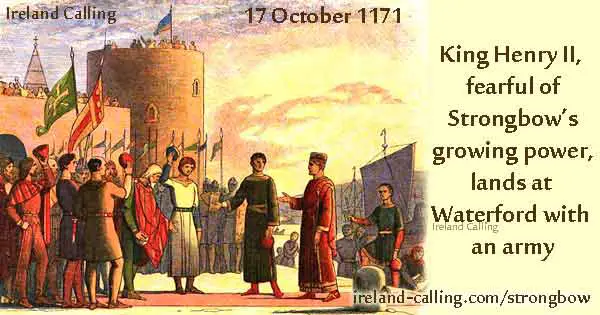The Earl of Pembroke, Richard Fitzgilbert de Clare, who is also known as Strongbow, was one of the key figures of the Norman invasion of Ireland. Strongbow was a fierce Norman knight who received his nickname because of his skills with a bow and arrow.
In the 1160s he was involved in conflict with Welsh princes over territories.
He and his allies were having a tough time against the Welsh and had lost several castles, land and peasants to the princes of Gwyned. While Strongbow was struggling against the Welsh, an Irish king was also having problems.
Diarmait MacMurrough, the King of Leinster, had been forced to flee his kingdom following a feud with a rival king.

MacMurrough arrived in Britain looking for help from King Henry II. However, Henry had difficulties of his own in France at the time and rather than get directly involved he gave MacMurrough permission to recruit help from his barons.
MacMurrough went to Strongbow for help
MacMurrough approached a number of barons including Strongbow, who found his offer too good to turn down. Strongbow, along with other barons, Robert FitzStephen and Maurice Fitzgerald, would be granted land in Ireland once MacMurrough was reinstated as king.
MacMurrough also promised his daughter Aoife’s hand in marriage to Strongbow and with it, an eventual succession to the position of King of Leinster. Strongbow was attracted by the offer and took encouragement from his belief that the Irish would not be nearly as well organised and hard to beat as the Welsh.

The barons took MacMurrough up on his offer and in 1167, he had been reinstated as King of Leinster. Strongbow went on to take control of Dublin, Waterford and Wexford.
Irish law said Strongbow couldn’t be king
When MacMurrough died in 1171, Strongbow inherited the position of King of Leinster. He was not without opposition as the kingship couldn’t pass down a female bloodline, nor could a foreigner become king.
However, Strongbow and his forces were far too powerful and nobody was able to stop him becoming king.
Strongbow’s new power made leaders on both sides of the Irish Sea very nervous. In England, Henry II had intended for his barons to help the King of Leinster regain control of his kingdom; he didn’t expect them to set up Norman colonies and become so powerful themselves.
In Ireland, the King of Connacht, Rory O’Connor, also wanted to put an end to Strongbow’s rise.
Strongbow’s conflict with Rory O’Connor
In 1171, O’Connor and his men marched on Dublin and put the city under siege. O’Connor was waiting for the citizens to be starved into submission. Strongbow attempted to make a deal.

He offered to submit to O’Connor on the basis that he would remain King of Leinster. However, O’Connor turned down the deal. He offered Strongbow Dublin, Waterford and Wexford instead.
This time Strongbow turned down the deal and launched a surprise attack on O’Connor’s troops.
In mid-afternoon, when the enemy would be least expecting an attack, Strongbow’s forces charged through the city gates and caught the Irish troops off guard.
The Norman knights were greatly outnumbered but due to the success of the timing of the attack, they were able to kill hundreds of Irish soldiers and take food and resources back into the city walls.

King of England was furious with Strongbow
King Henry II was furious that Strongbow had attempted to make a deal with O’Connor, it was an act that the English king saw as treason.
Strongbow visited Henry and submitted to him. It was agreed that Strongbow would remain King of Leinster but the towns of Dublin, Waterford and Wexford would belong to the English crown. Strongbow was also obliged to help Henry with his war in France.
Strongbow died five years later in 1176, his actions in establishing an Anglo-Norman presence in Ireland in the last decade of his life changed the course of Irish history for the next seven centuries. It was the beginning of what would eventually become British rule in Ireland.
More history articles
The Neolithics – first people to leave their mark on Ireland